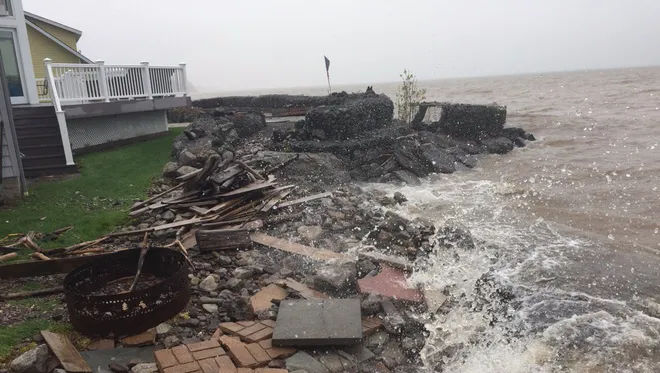Lakeshore Flood Warning Issued by the National Weather Service
A Lakeshore Flood Warning is published for an area that borders the lake, and while the water level rises, it serves as a warning that flooding in such areas is very likely. These warnings are important as elevators or other modes of transportation may be impacted.
The National Weather Service (NWS) issues such warnings in hopes of encouraging the exchange of useful information before disasters take place.
Due to high levels of water and strong winds, dangerous flooding becomes a possibility. This makes this warning very crucial for people who live in proximity to a lake.
Flood warnings are no joke. I witnessed a storm wind on Lake Michigan, where the calm and still waters turned into a treacherous zone.
These warnings have proven to save many lives and help in preserving domiciles. They always serve as a reminder for all to stay safe and get prepared.
What is a Lakeshore Flood Warning?
Lakeside flood warnings are published to forewarn people of an impending flooding situation. Coast flood warnings are issued as a result of the following factors.
Strong Winds:
Result in pushing of the water lake water on the coast shores.
Heavy Rains:
Result in pushing the water level in the lake to rise.
High Waves:
Resulting in the inundation of places behind the shores.
This Lakeside flood warning also identifies the threats of flooding, such as covering roads with rush waters, disintegration of shores, and damage to houses. Such people must pay heed to these warnings to remain devoid of danger.
Whether they occur gradually or very abruptly, floods originating from lakes are possible. Sometimes, storms may occur at a far distance but may still influence the water levels of your nearby lake. For this reason and many others, one must stay informed about weather updates and forecasts, even if the weather seems alright at the moment.
Why Are Lakeshore Flood Warnings Sent?
These Flood Warning signs given by the NWS are meant to help steer people into safe locations. They monitor the patterns of weather while taking note of wind, rainfall, and lake levels, expecting anything that has the possibility of leading to a flood. This reduces the chance of flooding by helping people prepare by:
- Protecting their houses.
- Staying away from places that might flood.
- Moving their important belongings to safer spots.
The warnings are usually sent out days prior to the predicted date, ensuring that people have enough time to prepare. Certain changes in the weather may, however, warrant less notice, which is why the flagged warning must still be taken seriously. For people residing near lakes, it makes sense to keep an eye out for changes in the forecasts.
Areas of Concern Due to Recent Lakeshore Flood Warnings:
Some regions adjacent to large lakes have faced Lakeshore Flood Warning recently. For example:
Buffalo, New York:
Water levels increased due to increases in the southwest winds, putting areas like Route 5 in Hamburg in danger of flooding. People living in low-lying places were required to relocate their vehicles and did not attempt to cross flooded roads.
Detroit, Michigan:
Neighborhoods located at a lower altitude near the lake were partly submerged due to massive waves and water. Water destruction also led to the closure of some parks and other recreational areas.
Other regions in proximity to lakes like Lake Ontario, Lake Superior, and Lake Huron tend to face flood warnings as well, and people in these areas are usually ready with sandbags and masks to protect their houses from flooding.
What Happens During A Lakeshore Flood Warning?
During a Lakeshore Flood Warning, the following actions are generally taken:
Submerged Roads:
Roads leading towards the lake may be submerged. Flooded roads can lead to traffic jams and delay the work of emergency services.
Water washing over the shore and strongly eroding is termed Shoreline Erosion. Damage could be inflicted on walking paths, trees, and even buildings, which is adjacent to the coast.
Property Damage:
Water from the lake can easily get into houses constructed on low ground, which can be hazardous. Items kept in garages, as well as basements, are the first to get damaged as these places are often the first to fill with water during floods.
Apart from all the mentioned effects, flooding can have an impact on normal day-to-day activities. There could be stagnant water that damages the electricity cables, which could result in a shortage of electricity as well as there could be public transport that can’t operate if the roads are too risky. If people are aware of what to expect, they can plan and be ready for these issues.
Safeguarding yourself when a watch is issued for Lake Shore floods.
The most essential component during a Lake Flood Watch is safety. To help you remain out of danger, look at the following pointers:
Stay Informed:
You can access the latest news or weather app to check for updates. Weather radios are also helpful as they continue operating when internet or phone services stop working.
Avoid Flooded Areas:
It is advisable not to walk or drive through roads that are flooded. Floodwaters can be perilous and deeper than how it seems. A car can lose control with as little as six inches of water, and walking through fast-moving water is unwise.
Protect Your Property:
Valuable items should be relocated to a higher position. Doors and windows should be secured tightly in order to keep water from coming in. If you own sandbags, use them around doors and low openings to stop water from entering.
Comply with the Guidance:
Depart as soon as authorities issue an evacuation order. If you wait, it may become increasingly difficult to depart as a result of prolonged evacuation delays.
Other things you can do include obtaining an emergency kit. You can also gather items like food, batteries, flashlights, a first aid kit, and even water. These supplies can help you stay self-sufficient should you require to remain indoors or shift to a sheltered area.
NWS’s Purpose in Weather Forecasting
During flood events, the national weather service has a paramount role they must carry out. They insist on doing the following:
Patterns of climate.
The height of the water in the lakes.
The activity of wind and waves.
Predictive alerts enable people to have enough time to fortify for a weather incident. During a school trip to a weather centre, I saw how predictive tools work. They told us the reasons why any changes in weather patterns, even the small ones, can cause problems to lakes are significant.
In preparation for a disaster, the NWS applies this information when working with state and local authorities to make sure everyone is correctly notified in time. They distribute alerts through various channels like TV, radio, and mobile devices, which guarantees every person has access to crucial information, even those who do not have the internet.
Personal Experience: Battling a Lakeshore Flood
A few years back, my region received a lakeshore flood alert. The winds were wild, and there was a lot of debris, including branches and garbage being blown around. My family moved our car to a different location and did not leave the house. With the warning issued, we were well prepared and avoided extensive damage.
There was a lot of cooperation, especially between the neighbours. One family gave sandbags to another while others assisted in moving heavy furniture to the upper floors. This served as a good reminder of why it is crucial to pay attention to the warnings and combat the problem as a community.
The Consequences of the Lakeshore Flooding
Flooding is harmful to people. It also has an impact on the environment. Some of these effects include:
Negatively Affecting Wildlife: Animals lose their homes when water floods their natural habitats. After a flood, birds, small mammals, and fish may find it hard to survive.
Soil Erosion occurs when the waves, which are caused by the flooding, wash away the land next to the shore. This can also result in the loss of vegetation, including shrubs and trees, which bind the soil in place.
Contaminated Water:
Pollution can occur due to the combination of trash and evil chemicals. The floodwater possesses the capability to carry oil, fertilizers, and other harmful materials into the lake, which will negatively impact the water quality.
Apart from this new development, flooding can also have a negative impact on businesses and tourism. There might be a financial blow to the community as parks, beaches, and trails that are located around the lake may remain closed for repair works.
Community Action Against Flood Warnings
During a flood warning, people in a community tend to help each other out a lot. Usually, they do the following:
Assist each other in trying to save homes from water damage.
Exchange insights and useful information among each other.
Cooperatively try to save and evacuate.
This has a great impact towards the positive side of the balance. Always there is a set of schools, churches, and community centres which, on a temporary basis, act as the shelter for invasion of people in dire need of protection. The volunteers offer food, clothing, and emotional help.
Local businesses do not remain behind. Some give away items like sandbags, water, and equipment, while others give discounts or provide things free of charge to the flood victims.
How to Prepare for Flood Warnings in the Future
Natural disasters are not something that we are able to prevent, but we can prepare. Some of the activities that can be undertaken include:
Construct More Barriers:
Planting or erecting walls at the shoreline will help bolster the shoreline’s defence. Trees and grass can also serve as wave barriers.
Have an Emergency Plan:
During a flood, it is essential to have planned your alternative routes. Talk to your family and agree on the evacuation routes so everyone knows.
Learn About Risks:
Do some research about the ecology in your region and identify areas that may be prone to flood. Join prepared community activities such as workshops to increase your knowledge about flood mitigation.
These measures will mitigate destruction and protect human life in the future. Stress levels when facing a flood are lower when one is fully prepared, allowing them to prioritize safety.







